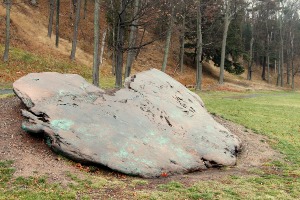
According to Dictionary.com, a boulder is “a detached and rounded or worn rock, especially a large one.” Back in the early 1600s, fur traders who were crossing Lake Superior heard stories of a large rock that was lying on the edge of the Ontonagon River. It was said that the boulder weighed five tons, was as big as a house, and was made of solid copper.
When trader Alexander Henry first saw the rock in 1766, he was so excited that he overestimated the weight of the boulder to be ten tons. He then reported that the copper was very pure and flexible, allowing him to take off a large piece. Henry R. Schoolcraft was intrigued by these rumors and searched for the legendary boulder. When he found it in 1819, he was disappointed by its size because it was smaller than the legends claimed. Schoolcraft estimated the weight, of what is now known as the Ontonagon Boulder, to be one ton or 1000 kilograms. The boulder was later found to be 1680 kilograms instead.
Ultimately, a prospector from Detroit named Julius Eldred bought the boulder, first from the Native Americans, and then from the federal government. He dragged the boulder through the woods, down the river on a raft, and then shipped it to Detroit where he proudly displayed what he found to the public. Later, a legal battle against the federal government regarding ownership of the boulder resulted in the government paying Eldred back more than four times the amount originally paid. Today, the Ontonagon Boulder is at the National Museum of Natural History in Washington, but not on display.
In the past, big copper boulders similar to the Ontonagon Boulder were found around the Keweenaw Peninsula in northernmost Michigan. A lot of this copper was originally placed by lava flow one billion years ago. When glaciation first began 2.6 million years ago, the cycles of glaciation and thawing eroded the top level of rock down to the level of the native copper ore.
The Keweenaw Peninsula was once covered by glaciers that were up to two miles thick. When the ice began to melt 10,000 years ago, the sliding ice cut pieces of native copper off the rocky surface and carried them along the ice. Subsequent abrasion from other rocks and minerals in the ice removed attached debris, forming a ‘floating’ piece of almost pure copper. When the glacier retreated, the floating pieces of native copper were left abandoned and scattered around upper Michigan. This process did not only make pieces of floating copper but also exposed valuable deposits of copper that were discovered and mined in the last one hundred years.
Native Americans started to utilize this natural resource as early as seven thousand years ago. By 3000 B.C., copper was used to make spear points, axe heads, knife blades, and decorative ornaments. The native copper pieces were pure enough that copper tools were fashioned directly out of the rock and pounded into shape. The indigenous people did not learn the tricks of smelting to produce refined copper until much later.
Industrial mining of the copper began in the mid-19th century and led to a “copper boom” in Northern Michigan. Almost all surface copper pieces were mined during this period and sent to smelters to produce pure copper metal. Today, a few of these “floating” copper pieces can be found on display around the state of Michigan.
[Source:
Amusing Planet
]

